Abstract
The present study comprises the second part of our previous work that dealt mainly with the phytochemical and physicochemical characterization of commercial unroasted green coffee beans, clove, cinnamon–clove and nutmeg ethanolic extracts of grape origin. In the present study, we focused on producing a discriminating model concerning commercial unroasted green coffee beans, clove, cinnamon, cinnamon and clove mixture (1:1, w/w), and nutmeg fine powders based on multivariate analysis of variance and supervised learning from tentative data of volatile compounds analysis, carried out with solid phase dynamic extraction in combination with gas chromatography–mass spectrometry. Results showed that 7 volatile compounds, i.e., ethylene, methanol, 3-methylpentane, ethyl acetate, 9-hexadecen-1-ol, toluene, and methyl acetate, could differentiate the investigated samples resulting in a 100% classification rate using the cross-validation method of linear discriminant analysis. Results were further confirmed using partial least squares regression analysis. The study contributes to the typification of commercial unroasted green coffee beans, cinnamon, clove, cinnamon and clove mixture, and nutmeg, based on selected volatile compounds. In addition, the study provides further support to the literature by means of a possible substitution of these products in rapid analysis tests, given the statistical models developed.
1. Introduction
Spices were used by ancient Egyptians and during the Middle Ages for flavoring and medicinal purposes, but also for food preservation [1]. Spices have a considerable antioxidant activity that is attributed to their high content of polyphenols, terpenoids and flavonoids [2]. Nowadays, some spices are more expensive than others, given their special flavoring and aromatic or coloring properties [3]. Muzolf-Panek and Struper-Szablewska [2] reported that the high antioxidant activity of clove (Syzygium aromaticum) is associated with flavonoids, and in general with total phenolic content. Numerous research studies in the recent literature have highlighted the importance of phytochemicals to human health. Cinnamon, which has around 250 species (Cinnamomum genus), is one of the most well-known and widely used spices around the world [4]. The most important health benefits of cinnamon are its antioxidant activity, antimicrobial properties, and anti-inflammatory effects [5], attributed mainly to its high content of cinnamaldehyde and the considerable content of eugenol [6]. Furthermore, a spice that is of great importance in cuisines around the world is nutmeg (Myristica fragrans). Nutmeg consists mainly of essential oils (10%) and lipids (30–40%) and has a distinctive odor due to the presence of terpenoids contained in its essential oils [7]. Recent studies have reported that nutmeg has antioxidant activity, but also numerous health benefits, such as antidysentery, nerve stimulant and anti-inflammatory properties [8]. Regarding beverages, coffee and tea are probably the most famous beverages in the world. The main cultivated species of coffee are Arabica (Coffea arabica L.) and Robusta (Coffea canephora). Arabica coffee may be easily adulterated with Robusta coffee, which is cheaper [9]. Coffee beans before roasting contain a high content of polyphenols and chlorogenic acids, like caffeic acid [10,11], that are responsible for their high antioxidant activity [12]. Food typification is a recent and important topic, concerning the numerous food scandals that have been reported [3,9,13]. Among foods of plant origin, spices, beverages (such as coffee), fruit juices, etc., are often subjected to substitution for many reasons, mostly for economic value, the documented health-beneficial properties these have (so cheaters may gain higher profit sue to the already well-known health claims), and country of origin [3,13]. Therefore, there is a growing demand by the food authorities and industry for genuine products. In this context, numerous analytical techniques have been developed to determine food authentication and food fraud, including biological methods, such as polymerase chain reaction (PCR), DNA methods and gel electrophoresis. In addition, chromatographic and spectrometric techniques are commonly used to identify food adulteration [14], like isotope ratio mass spectrometry (IRMS), gas chromatography coupled to mass spectrometry (GC–MS) in combination with solid phase extraction techniques, nuclear magnetic resonance (NMR), and inductively coupled plasma optical emission spectrometry (ICP–OES), along with nanoscale separation techniques, such as capillary–nano liquid chromatography (Nano LC), capillary electrophoresis–electro chromatography (CE–CEC) [15], and nano-liquid chromatography coupled to mass spectrometry (Nano LC–MS) [16]. The data collected through these analytical techniques are subjected to chemometrics [17]. Normally, most of the research studies in the literature dealing with authentication and quality control of beverages and spices use many samples [18,19,20], which makes the application of authenticity and quality protocols time consuming and complicated in terms of data treatment [21]. Furthermore, there are limited studies available in the literature focusing on the determination of volatile compounds as adulterants in spices such as cinnamon [18]. Considering the recent literature, and motivated by our previous study, in which ethanol of grape origin was introduced as a green solvent for the extraction of phytochemical compounds from green coffee and selected spices with the potential to be used as new sources of food preservation [12], the main scope of the present study was to identify any key volatile markers of unroasted green coffee beans, clove, cinnamon, cinnamon and clove mixture, and nutmeg powders, using supervised learning, such as linear discriminant analysis (LDA) and partial least squares regression (PLS) on the data for volatile compounds determined with solid phase dynamic extraction in combination with gas chromatography–mass spectrometry (SPDE–GC–MS). For this purpose, discriminant equations were developed. The results obtained in the present study might be of interest for the typification and substitution control of unroasted green coffee beans, clove, cinnamon, cinnamon and clove mixture, and nutmeg in rapid analysis tests. To our knowledge, there is not any other recent study with the hypothesis herein, thus constituting the novelty of the present research work.
2. Materials and Methods
2.1. Preparation of Green Coffee, Clove, Cinnamon, Cinnamon and Clove Mixture, and Nutmeg Fine Powders
Unroasted green coffee beans (Coffea arabica, Guatemala Jasmin SHB EP), clove (Syzygium aromaticum, Greece), cinnamon (Cinnamomum burmanni, Indonesia), and nutmeg (Myristica fragrans, Indonesia) samples originating from a large sample size stored in bulk packages (30–100 kg) were purchased from a local store in Agrinio (Aitoloakarnania, Greece). Three samples (n = 3) of each material were shattered into a fine powder using a blender (Rohnson, Heavy duty, Prague, Czechia Republic, Republic of Korea) and combined in each case, prior to the determination of volatile compounds. The mixture of cinnamon and clove samples was prepared by blending equal proportions of the spices (1:1, w/w). The sample design used was chosen in order to simulate rapid analysis tests.
2.2. Extraction of Volatile Compounds
For the extraction of volatile compounds of unroasted green coffee beans, clove, cinnamon, cinnamon and clove mixture, and nutmeg powders, an NCT-SPNDL-01/AC-50-74 SPDE Needle 74 mm, 50 μm PDMS–AC coated fiber (BGB Analytik, Lörrach, Germany) was used. Each sample (ca. 1 g) was placed in a 20 mL volume screw-cap vial equipped with PTFE–silicone septa. For solid phase dynamic extraction (SPDE), the vials were placed in the chamber of an autosampler at an incubation temperature of 45 °C. The syringe temperature was 35 °C. The pre-incubation time was 3 min, and the conditioning time was 5 min. Between the analyses of each sample, there was 1 min delay to avoid any contamination. In addition, blank runs were carried out to avoid any matrix effects [12].
2.3. Determination of Volatile Compounds: Instrumentation and Tentative Verification
The samples of unroasted green coffee beans, clove, cinnamon, cinnamon and clove mixture, and nutmeg fine powders were subjected to analysis using a Thermo Scientific gas chromatograph (TRACE GC Ultra) connected to a DSQ II mass spectrometer. An Agilent DB-624 UI capillary column was used for the isolation of volatile compounds. The capillary column had the following characteristics: 20 m length × i.d 0.18 mm, × 1 μm film thickness. In addition, the capillary column surface consisted of 6% cyanopropyl–phenyl, and 94% polydimethylsiloxane. The temperature program within the oven was as follows: 40 °C for 5 min, expanded to 90 °C at a rate of 15 °C/min (0 min hold), and finally expanded to 220 °C at a rate of 30 °C/min (3 min hold).The ion source temperature was 200 °C. Mass spectra were recorded in the electron impact mode at the ionization voltage of 70 eV. The mass range of the identified compounds was 45–260 (m/z) and the analysis was carried out at the positive mode [12]. Helium served as the carrier gas. Each sample was run in duplicate (n = 2) and the third replicate (n = 2 + 1) comprised the mean value (n = 1) according to the theory of missing values analysis introduced by Graham [22]. The volatile compounds in the analyzed samples were identified using the mass spectral library (NIST MS Search 2.0) packed in the GC–MS software, also comparing the dominant m/z values determined in the present and previous studies dealing with plant-based foods and listed in the mass spectral library. For the estimation of each volatile compound’s contribution (%), the spectral area of each single identified compound was divided by the total area of the identified volatile compounds, assuming a response factor equal to 1 [19,23] for all the identified compounds. Results were reported as percentage (%) ± standard deviation (SD).
2.4. Statistical Analysis
The average values of the tentatively identified volatile compounds (%) were treated with multivariate statistical analysis. The average values were compared using multivariate analysis of variance (MANOVA) to indicate any statistically significant (p < 0.05) differences in the volatile compounds’ occurrence among the samples (three samples in each case). The basic rule of MANOVA is to generate any new dependent variables, considering the linear combination of all the dependent variables (i.e., volatile compounds) in the multivariate linear model, which could increase as much as possible the differences in the average values among the groups of independent variables (i.e., unroasted green coffee beans, clove, cinnamon, cinnamon and clove mixture, and nutmeg fine powders). Normally, in MANOVA the basic tests of the multivariate testing are computed (Wilks’ Lambda and Pillai’s Trace test statistics) to indicate and record the main effects and interaction of the independent variables at the multidimensional level [24]. Another important piece of information that is revealed during MANOVA is the effectiveness of the sample size used in the analysis. This effectiveness is monitored by the observed power. Regarding power, this is the probability of rejecting the hypothesis that the means are equal when these are in fact not equal. Many parameters in MANOVA affect the power: (i) sample size, (ii) the magnitudes of the variances, (iii) the level of significance (alpha level), and (iv) the actual difference among the population means in each group of objects. However, this analysis is based on a high power concept. The high power indicates that there is a high probability of rejecting the null hypothesis when the null hypothesis is false [24].
LDA is a supervised statistical technique that aims to find a linear combination of statistically significant objects of interest (i.e., volatile compounds indicated during MANOVA, parameter X) that separate two or more groups of objects (i.e., unroasted green coffee beans, clove, cinnamon, cinnamon and clove mixture, and nutmeg fine powders, parameter Y):
where a1, a2, ……….an are the discriminant function coefficients.
The suitability of the prediction ability of the LDA models was evaluated by the cross-validation method, during which each case is classified by the functions derived from all cases other than that particular case [24]. In addition, the tolerance test for each volatile compound introduced in the discrimination model was evaluated. The tolerance test is a basic criterion during the LDA for the selection of the most appropriate variables to be inserted in the discrimination model, so the maximum discrimination can be achieved [24]. During LDA the tolerance test is run a priori by the SPSS software. Therefore, there is n pre-processing. At the same time, the analyst must evaluate the group centroid values during LDA. The group centroid values are mandatory informative data that show the classification ability of the LDA model. The group centroid values indicate the unstandardized canonical discriminant functions at the mean values of the groups of objects subjected to analysis. The centroid values physically show the coordinates at the multidimensional level. In this context, the abscissa is the first discriminant function, and the ordinate is the second discriminant function [24]. Regarding the LDA analysis, the unroasted green coffee beans and spices powders (studied samples) were considered as the factor variable (grouping variable), and the data of the volatile compounds as the independent variables. To evaluate further the statistical analysis data, partial least squares (PLS) regression analysis, commonly known as projection to latent structure, was used. PLS is a bilinear statistical technique that is used to find the elementary relations between two matrices (X and Y) to indicate a factorial model, e.g., a latent variable approach to modeling the covariance structures in the space of X and Y. Therefore, it creates a linear regression model by projecting the predicted variables and the observable variables onto a new space of maximum covariance. The variables’ importance in projection (VIP) scores were calculated for each volatile compound (component) and those having values greater than 1 were considered in the analysis as potential volatile indicators of the studied matrices [25]. In principle, the VIP scores show the importance of the X-variables in PLS multivariate models [26]. The statistical treatment of data was accomplished using SPSS statistics software (version 28.0, IBM Inc., Armonk, NY, USA, 2021).
3. Results
3.1. Volatile Compounds in Unroasted Green Coffee Beans and Selected Spice Powders
The number of the tentatively identified volatile compounds using SPDE-GC–MS in unroasted green coffee beans, clove, cinnamon, cinnamon and clove mixture, and nutmeg fine powders was 60, as reported in our parental study [12]. In that study, we classified the identified compounds into those with a higher and lower probability level according to the NIST mass spectral library, and non- supervised statistical methods, such as factor analysis, showed the impact of these compounds on the purity control of the studied samples (unroasted green coffee beans, cinnamon and clove mixture, and nutmeg fine powders). In addition, no volatile compound’s data have been reported in previous study [12], until now, for individual samples of cinnamon and clove fine powders. Meta-data analysis of the results. carried out in the present research, showed that 16 volatile compounds could be used for the classification of samples. As can be seen in Table 1, the volatile compounds belong to different classes, such as alcohols, esters, hydrocarbons, ketones, phenolic compounds, terpenoids, and vitamin derivatives. Volatile compounds are numbered and listed according to retention time (RT) and information on their molecular formula (MF), along with the dominant mass to charge ratio (m/z). What is worth noting is that the proportions of these volatile compounds are associated with the origin of the studied samples given the significant (p < 0.05) differences that were observed during MANOVA. In addition, significant (p < 0.05) differences were also observed for specific classes of the identified compounds. Figure 1 represents the percentage of tentatively volatile compound groups in each sample.

Table 1.
Volatile compounds tentatively identified in unroasted green coffee beans and selected spice powders.
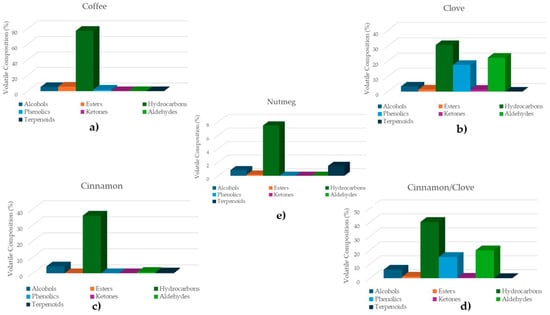
Figure 1.
Classes of volatile compounds (% average values) tentatively identified in (a) unroasted green coffee beans (b) clove, (c) cinnamon, (d) cinnamon and clove mixture, and (e) nutmeg powders.
Another critical point to discuss is that specific volatile compounds were not identified in all the studied samples (Table 1), providing feasibility for the typification of individual samples (unroasted green coffee beans, cinnamon, clove, cinnamon and clove mixture, and nutmeg fine powders). The representative gas chromatograms of unroasted green coffee beans, clove, cinnamon, cinnamon and clove mixture, and nutmeg fine powders are shown in Figure 2, Figure 3, Figure 4, Figure 5 and Figure 6, respectively.
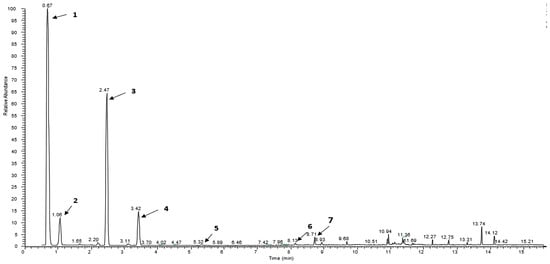
Figure 2.
Representative gas chromatogram of unroasted green coffee bean powder indicating some key volatile compounds tentatively identified. (1) Ethylene, (2) methanol, (3) 3-methylpentane, (4) ethyl acetate, (5) 9-hexadecen-1-ol, (6) toluene, (7) 2-chloro-2-nitropropane.
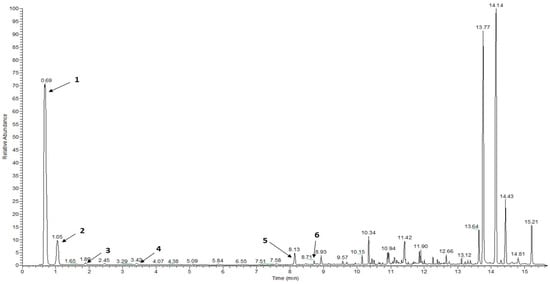
Figure 3.
Representative gas chromatogram of clove powder indicating key volatile compounds tentatively identified. (1) Ethylene, (2) methanol, (3) methyl acetate, (4) ethyl acetate, (5) toluene, (6) 2-chloro-2-nitropropane.

Figure 4.
Representative gas chromatogram of cinnamon powder indicating key volatile compounds tentatively identified. (1) Ethylene, (2) methanol, (3) 9-hexadecen-1-ol, (4) 2-chloro-2-nitropropane.
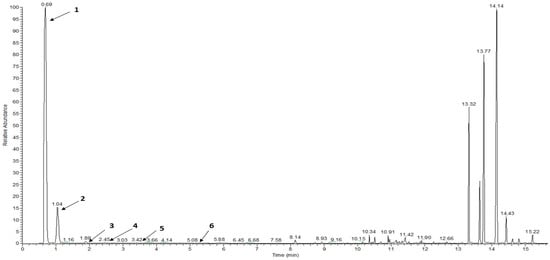
Figure 5.
Representative gas chromatogram of cinnamon and clove mixture powder indicating key volatile compounds tentatively identified. (1) Ethylene, (2) methanol, (3) methyl acetate, (4) 3-methylpentane, (5) ethyl acetate, (6) 9-hexadecen-1-ol.
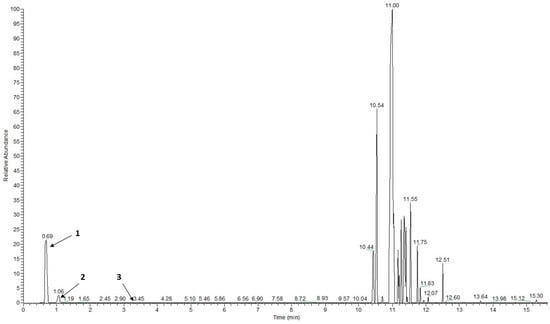
Figure 6.
Representative gas chromatogram of nutmeg powder indicating key volatile compounds tentatively identified. (1) Ethylene, (2) methanol, (3) ethyl acetate.
3.2. Classification of Unroasted Green Coffee Beans and Selected Spice Powders Using Volatile Compounds Tentatively Identified and Supervised Learning
3.2.1. MANOVA: Qualitative Criteria and Analytical Data
The multivariate hypothesis testing, considering the Pillai’s Trace and Wilks’ Lambda indices, both having an observed power of 1000, showed that there was a significant impact of the origin of samples (unroasted green coffee beans, clove, cinnamon, cinnamon and clove mixture, and nutmeg fine powders) on their volatile composition (%). This strong effect is shown by the interval values of Pillai’s Trace and Wilks’ Lambda (Table 2). In principle, the lower the Wilks’ Lambda values the higher the differences between groups of subjects. In cases where the Wilks’ Lambda value is 0.000, the clearer the differences among the studied groups. The multivariate effect of the analysed samples regarding their volatile compounds is shown by the F-value tests. These tests are based on linearly independent pairwise comparisons among the estimated marginal means. Among the 16 identified volatile compounds, all showed significant differences (p < 0.05) in their composition according to the studied matrices.

Table 2.
Analytical values of MANOVA indices during multivariate testing of volatile compounds in unroasted green coffee beans and selected spice powders.
3.2.2. LDA: Pre-Processing of Data, Visualization of Results and Decisions
Prior to the final LDA, pre-processing of data showed that nine volatile compounds did not pass the tolerance test and were not used in the LDA model (Table 1). The tolerance test specifies the minimum tolerance a variable can have. Notably, a variable with very low tolerance is nearly a linear function of the other variables, and its inclusion in the analysis would make the calculations unstable. The default tolerance of the variables during LDA is 0.001. Therefore, LDA analysis was conducted using seven volatile compounds: ethylene, methyl alcohol, 3-methylpentane, ethyl acetate, 9-hexadecen-1-ol, toluene, and methyl acetate. Both prior probabilities from the menu option of the SPSS program were considered: (i) all groups are equal, and (ii) compute from group sizes, indicating the same classification results. Therefore, we proceeded to the final step of LDA. Four discriminant functions were formed that had the following metrics: (i) Wilks’ Lambda = 0.000 (X2 = 259.073, df = 28, p = 0.000) for the first function, (ii) Wilks’ Lambda = 0.000 (X2 = 119.618, df = 18, p = 0.000) for the second function, (iii) Wilks’ Lambda = 0.001 (X2 = 58.699, df = 10, p = 0.000) for the third function, and (iv) Wilks’ Lambda = 0.053 (X2 = 23.535, df = 4, p = 0.000) for the fourth function. The total variance explained by the four discriminant functions was 100%. Another critical point to discuss is that of the eigenvalues the discriminant functions must have during LDA. The eigenvalue of the discriminant function is an essential parameter, since it provides information on how well the function differentiates the initial groups (i.e., unroasted green coffee beans, clove, cinnamon, cinnamon and clove mixture, and nutmeg fine powders). Therefore, the higher the eigenvalue in LDA, the higher the classification rate. In our case, the respective eigenvalues were 37,202,734,888, 2,027,145, 80,080, and 17,952 for discriminant function 1, discriminant function 2, discriminant function 3, and discriminant function 4. The group centroid values were: (9960.019, 0.226), (−2488.112, −3.677), (−2557.181, 29.060), (−2457.509, 39.974), and (−2457.218, −65.583) for green coffee, clove, cinnamon, cinnamon and clove, and nutmeg, respectively, showing the sample grouping (Figure 7). The total classification rate was 100% for the original and 100% for the cross-validation method.
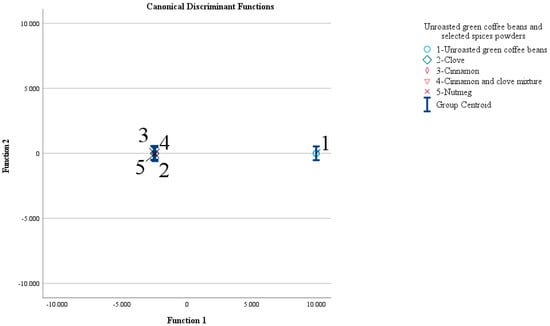
Figure 7.
Classification of unroasted green coffee beans and selected spice powders using 7 volatile compounds and LDA.
The volatile compounds that contributed most to the discrimination of unroasted green coffee, clove, cinnamon, cinnamon and clove mixture, and nutmeg fine powders were those pooled with the highest absolute correlation value within the discriminant functions. These were 3-methylpentane for discriminant function 1, ethylene for discriminant function 2, methyl acetate for discriminant function 3, and ethyl acetate for discriminant function 4. Therefore, these volatile compounds are strongly correlated with the samples studied (Table 3).

Table 3.
Correlation of volatile compounds to the structure matrix of the discriminant functions in LDA.
The Fisher’s linear discriminant functions obtained through LDA, regarding unroasted green coffee beans, clove, cinnamon, cinnamon and clove mixture, and nutmeg, are represented in Figure 8.
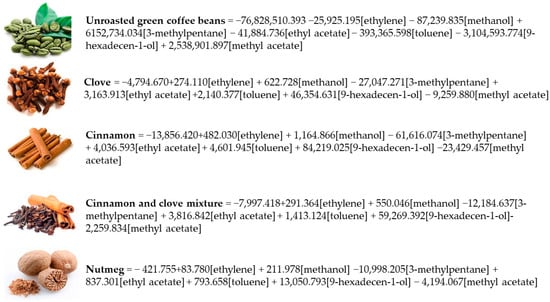
Figure 8.
Discriminant function equations for unroasted green coffee beans and selected spices powders based on key volatile compounds tentatively identified with SPDE-GC/MS and indicated by LDA.
3.2.3. PLS: Exploration of Key Volatile Compounds
The results of PLS regression analysis showed that among five latent factors (for the different samples studied) the best results were obtained for latent factors 4 and 5. The cumulative explained X variance was 0.996 resulting in a cumulative Y variance of R2 = 0.915 and adjusted R2 = 0.881 for latent factor 4. Similarly, explained cumulative X variance was 0.999 resulting in a cumulative Y variance of R2 = 0.952 and adjusted R2 = 0.925 for latent factor 5. In this context, the variance importance in projection (VIP) scores > 1 obtained for the independent variables (i.e., volatile compounds) were VIP = 1.333 (latent factor 4) and 1.309 (latent factor 5) for toluene, and VIP = 1.230 (latent factor 4) and 1.211 (latent factor 5) for methyl acetate. Therefore, these volatile compounds indicated by PLS were the key volatile compounds (factors) that were mostly related to the unroasted green coffee beans and selected spice powders.
4. Discussion
Concerning the analysis of volatile compounds in coffee, most recent studies deal with roasted and brewed coffee [29]. What is remarkable is that the number of volatile compounds identified in thermally processed coffee is almost 1000, indicating the complexity of its composition. Indeed, during thermal processing of coffee beans, a considerable number of reactions occur, including thermal degradation, pyrolysis, Maillard reaction, Strecker degradation, oxidative degradation, direct degradation, interaction with reduced sugars, other degradation, autooxidation, preservation and condensation [30]. As a result, there are numerous classes of volatile compounds, including pyridines, pyrroles, organosulfur compounds, oxazoles, pyrazines, aldehydes, thiazoles, furans, carboxylic acids, ketones, alcohols, esters, carotenoids, phenols, and unsaturated lactones [30]. Headspace analysis in combination with gas chromatography–mass spectrometry is the most widely used technique for the analysis of volatile compounds in coffee and other foodstuffs [30,31]. Dynamic headspace extraction has been characterized by high sensitivity, and thus, in the analysis of complex matrices like coffee, can provide greater flexibility and compound coverage [32]. Among the volatile compounds of interest, unroasted green coffee powder showed the highest proportions for ethyl acetate, ethylene, 3-methylpentane, and 2-chloro-2-nitropropane compared to clove, cinnamon, cinnamon and clove mixture, and nutmeg powders. Regarding clove powder, the highest proportions of volatile compounds were observed for decane, eugenol, 2-nonanone, and retinal (Vitamin A aldehyde). In a recent study [33], it was reported that clove essential oil is rich in eugenol, eugenol acetate, β-caryophyllene, and α-humulene. Cinnamon samples had the highest proportions of ethylene and methanol. For cinnamon and clove powders, the highest proportions were observed for ethylene, retinal, eugenol, and methanol. A relevant study in the literature [34] reported the presence of methyl salicylate in cinnamon (Cinnamomum verum) samples. In our case, methyl salicylate was not identified in cinnamon powders. In the present study, we analyzed different cinnamon species, such as Cinnamomum burmanni from Indonesia, indicating the impact of the botanical and geographical origin of cinnamon on its volatile composition. Another critical point to discuss is the presence of some lesser known volatile compounds in plant-based foods, such as 3-methylpentane, toluene, and methanol, apart from knowledge of chemical solvents. Regarding 3-methylpentane, this is a common volatile compound found in many plant species, such as winter oil seed rape, apricot, sweet cherry, European plum, peach and common pear [35]. In another study, 3-methylpentane was reported to be a volatile compound in pepper [36].
Similarly, toluene has been identified within several different plant sources, such as black walnuts, rosemary, and coriander. Toluene has also been identified in several different foods, such as prickly pears, citrus, yellow bell peppers, apples, and garden tomato [37,38]. In addition, toluene can be emitted by different plants and trees (sunflower and pine, respectively) during an attack of pathogens [39]. Finally, the presence of methanol in plant-based foods is rather common, as methanol originates from the hydrolysis of pectin, as shown by the breakdown of the esterified galacturonic acid moieties [40]. What is also remarkable is that the mixture of cinnamon and clove had different proportions of the respective volatile compounds compared to individual samples. Notably, volatile substances, such as esters, alcohols and ketones, in cinnamon and clove mixture are reduced compared to those in clove or cinnamon. This finding indicates the transformation, regeneration, compositional differentiation, or even loss of volatile compounds during the mechanical processing and mixing of certain spices. In addition, the conditions of analysis carried out, the fiber used for the extraction of the volatile compounds, the equipment, and the origin of the samples may also impact the volatile profile of individual spices or mixtures of spices, via a given antagonism among the determined volatile compounds. However, in all cases, these variations, when supported by chemometrics, may provide a clear result regarding the purity and typification of the studied product, a finding that can only be considered in authenticity and quality control studies. Finally, nutmeg powder had the highest proportions in terpinen-4-ol [4-methyl-1-(1-methylethyl)-3-cyclohexen-1-ol]. Most of these volatile compounds have a special aroma note (Table 1). Fake flavored beverages and spices affect consumers’ food choice and preferences, as the naturalness of these goods is altered by artificial flavors [41] and, of course, this can harm the health of consumers in the case of toxic adulterants. Indeed, in a recent study [42] carried out in 23 European countries and including 1885 samples of herbs and spices (oregano, pepper, cumin, turmeric, saffron, paprika, etc.), the authors reported that more than half of the analyzed samples contained amounts of undeclared plant material. In addition, about 1 in 50 samples contained unauthorized food dyes. Several samples were also found to have higher than the allowed levels of copper, and one sample also contained dangerously high levels of the carcinogenic chemical lead chromate.
Previous studies in the literature concerning the authentication or adulteration control of roasted coffee have reported high classification (88–100%) results based on DNA or 1H NMR data (triacyl-glycerides, diterpenes, acetic acid, formic acid, caffeine, trigonelline, N-methylpyridine, furfuryl alcohol, 5-hydroxymethylfurfural, hydroxycinnamic acids, furans, esters, N-heterocyclic and sulfur compounds) in combination with supervised (PLS and LDA) statistical techniques [41,42,43], in agreement with the results of the present study, which showed a clear separation of unroasted coffee powder from the selected spice powders. In addition, unsupervised statistical techniques, such as principal component analysis (PCA), have also provided high explained variance (>90%) in coffee samples roasted to different degrees, based on volatile compounds [44]. Regarding spices, previous studies in the literature successfully demonstrated the geographical origin differentiation of saffron samples from different regions based on rapid tests of analysis using a portable hyperspectral imaging system, in combination with partial least squares and LDA (PLS-LDA). The classification rate was 100% [31]. Liu et al. [45], using multi-element and stable isotope analyses based on ICP–MS and ICP–OES in combination with LDA, reported a perfect classification (100%) of tea samples from different geographical origins. Similarly, Pages-Rebull et al. [46] developed statistical models for the characterization, identification and authentication of cinnamon, oregano, thyme, sesame, bay leaf, clove, cumin, and vanilla samples based on sesamol, eugenol, thymol, carvacrol, salicylaldehyde and vanillin, along with multivariate statistics, such as PCA, PLS–DA, and soft independent modelling of class analogy (SIMCA). PLS–DA classified samples with a high prediction rate (>99%) are in agreement with the present results. More recently, de Matos et al. [47] classified commercial samples of Brazilian Equisetum tea using phenolic compounds (glycoside derivatives of kaempferol, derivatives of stirilpirone, derivatives of chrysin, glycosides of quercetin, cinnamic acids, etc.) and chemometrics, such as PCA, hierarchical cluster analysis (HCA) and PLS–DA. The supervised learning technique (PLS–DA) provided the most robust classification of samples. Finally, it is quite evident from the literature that metrics data for foods (foodometrics) [17], along with the most recent advancements/trends in analytical methodologies, can be a decisive tool for the authentication and quality/adulteration control of beverages, herbs and spices [45,46,47,48].
5. Conclusions and Future Directions
Results of the present study showed that the volatile fingerprint of commercially available unroasted green coffee beans and selected spices, such as clove, cinnamon, cinnamon and clove mixture, and nutmeg powders, is characteristic and the tentative data for volatile compounds could be further used for the development of a machine learning algorithm based on supervised statistical learning, in terms of linear discriminant analysis and partial least squares regression. Both prior probabilities during LDA, i.e., considering the groups as equal or comparing the group sizes, gave the same results, indicating that the LDA model presented herein, combined with PLS, could be further exploited in authenticity and substitution control of beverages, spices or herbs introduced to the market, via rapid analysis tests considering the key volatile compounds. To our knowledge, limited data is available for this hypothesis, thus constituting the novelty of the current study, even if preliminary in nature, based mainly on the small number of samples that it was possible to collect; on the other hand, it was crucial to build a rapid analysis test protocol. Future directions may comprise the purchase of standard compounds concerning the key volatile compounds that contributed to the absolute classification of the samples, providing at the same time quantitative statistical models and the use of a larger number of samples from different countries, in order to strengthen the present results concerning the development of a supervised learning protocol for rapid analysis tests.
Author Contributions
Conceptualization, I.K.K., V.K.K. and D.G.L.; methodology, I.K.K. and V.K.K.; software, N.D.A.; validation, I.K.K. and N.D.A.; formal analysis, D.G.L., E.K.K. and E.N.M.; investigation, D.G.L., E.K.K., E.N.M., V.K.K. and I.K.K.; resources, N.D.A. and I.K.K.; data curation, D.G.L., I.K.K., V.K.K. and N.D.A.; writing—original draft preparation, D.G.L. and I.K.K.; writing—review and editing, D.G.L. and I.K.K.; supervision, I.K.K.; project administration, I.K.K., D.G.L., V.K.K. and N.D.A.; funding acquisition, I.K.K. All authors have read and agreed to the published version of the manuscript.
Funding
This research received no external funding.
Data Availability Statement
All relevant data can be found within the study.
Acknowledgments
The authors are grateful to the Department of Research, Innovation and Entrepreneurship of the University of Patras for financial support concerning the consumables in this research. The authors are also grateful to Eurofins Athens Analysis Laboratories S.A., Nafpliou 29, Metamorfosi, 14452 Athens, Greece for the analysis of volatile compounds.
Conflicts of Interest
The authors declare no conflicts of interest.
References
- Raghavan, S. Handbook of Spices, Seasonings, and Flavorings: Forms, Functions, and Applications of Spices; CRC Press: Boca Raton, FL, USA, 2007. [Google Scholar]
- Muzolf-Panek, M.; Stuper-Szablewska, K. Comprehensive Study on the Antioxidant Capacity and Phenolic Profiles of Black Seed and Other Spices and Herbs: Effect of Solvent and Time of Extraction. J. Food Meas. Charact. 2021, 15, 4561–4574. [Google Scholar] [CrossRef]
- Velázquez, R.; Rodríguez, A.; Hernández, A.; Casquete, R.; Benito, M.J.; Martín, A. Spice and Herb Frauds: Types, Incidence, and Detection: The State of the Art. Foods 2023, 12, 3373. [Google Scholar] [CrossRef] [PubMed]
- Willis, S.; Sunkara, R.; Hester, F.; Shackelford, L.; Walker, L.T.; Verghese, M. Chemopreventive and Anti-Inflammatory Potential of Select Herbal Teas and Cinnamon in an In-Vitro Cell Model. Food Nutr. Sci. 2019, 10, 1142. [Google Scholar] [CrossRef][Green Version]
- Rao, Y.K.; Fang, S.-H.; Tzeng, Y.-M. Evaluation of the Anti-Inflammatory and Anti-Proliferation Tumoral Cells Activities of Antrodia Camphorata, Cordyceps Sinensis, and Cinnamomum Osmophloeum Bark Extracts. J. Ethnopharmacol. 2007, 114, 78–85. [Google Scholar] [CrossRef]
- Hossain, M.; Brunton, N.; Barry-Ryan, C.; Martin-Diana, A.B.; Wilkinson, M. Antioxidant Activity of Spice Extracts and Phenolics in Comparison to Synthetic Antioxidants. Rasayan J. Chem. 2008, 1, 751–756. [Google Scholar]
- Naeem, N.; Rehman, R.; Mushtaq, A.; Ghania, J.B. Nutmeg: A Review on Uses and Biological Properties. Int. J. Chem. Biochem. Sci. 2016, 9, 107–110. [Google Scholar]
- Khanam, M.; Dar, A.H.; Beg, F.; Khan, S.A.; Nayik, G.A.; Karabagias, I.K. Chapter 15: Nutmeg Essential Oil. In Essential Oils: Extraction, Characterization and Applications; Nayik, G.A., Mohammad, J.A., Eds.; Academic Press: Cambridge, MA, USA; Elsevier: Amsterdam, The Netherlands, 2023; Volume 15, pp. 391–399. [Google Scholar] [CrossRef]
- de Carvalho Couto, C.; dos Santos, D.G.; Oliveira EM, M.; Freitas-Silva, O. Global Situation of Reference Materials to Assure Coffee, Cocoa, and Tea Quality and Safety. TrAC-Trends Anal. Chem. 2021, 143, 116381. [Google Scholar] [CrossRef]
- Sualeh, A.; Tolessa, K.; Mohammed, A. Biochemical Composition of Green and Roasted Coffee Beans and Their Association with Coffee Quality from Different Districts of Southwest Ethiopia. Heliyon 2020, 6, e05812. [Google Scholar] [CrossRef] [PubMed]
- Clifford, M.N.; Kerimi, A.; Williamson, G. Bioavailability and Metabolism of Chlorogenic Acids (Acyl-Quinic Acids) in Humans. Compr. Rev. Food Sci. Food Saf. 2020, 19, 1299–1352. [Google Scholar] [CrossRef]
- Lazaridis, D.G.; Karabagias, V.K.; Karabagias, I.K.; Andritsos, N.D.; Giannakas, A.E. Physicochemical and Phytochemical Characterization of Green Coffee, Cinnamon Clove, and Nutmeg EEGO, and Aroma Evaluation of the Raw Powders. Eur. Food Res. Technol. 2023, 250, 83–96. [Google Scholar] [CrossRef]
- Karabagias, I.K. Food Authentication and Adulteration Control Based on Metrics Data of Foods and Chemometrics. Eur. Food Res. Technol. 2024, 250, 1269–1283. [Google Scholar] [CrossRef]
- García-Pérez, P.; Becchi, P.P.; Zhang, L.; Rocchetti, G.; Lucini, L. Metabolomics and Chemometrics: The Next-Generation Analytical Toolkit for the Evaluation of Food Quality and Authenticity. Trends Food Sci. Technol. 2024, 147, 104481. [Google Scholar] [CrossRef]
- Aydoğan, C. Nanoscale separations based on LC and CE for food analysis: A review. TrAC-Trends Anal. Chem. 2019, 121, 115693. [Google Scholar] [CrossRef]
- Aydoğan, C. Critical review of new advances in food and plant proteomics analyses by nano-LC/MS towards advanced foodomics. TrAC-Trends Anal. Chem. 2024, 176, 117759. [Google Scholar] [CrossRef]
- Karabagias, I.K. Advances of Spectrometric Techniques in Food Analysis and Food Authentication Implemented with Chemometrics. Foods 2020, 9, 1550. [Google Scholar] [CrossRef] [PubMed]
- Ballin, N.Z.; Sørensen, A.T. Coumarin Content in Cinnamon Containing Food Products on the Danish Market. Food Control 2014, 38, 198–203. [Google Scholar] [CrossRef]
- Kuballa, T.; Brunner, T.S.; Thongpanchang, T.; Walch, S.G.; Lachenmeier, D.W. Application of NMR for Authentication of Honey, Beer and Spices. Curr. Opin. Food Sci. 2018, 19, 57–62. [Google Scholar] [CrossRef]
- Borém, F.M.; de Abreu, G.F.; Ferreira, A.G.; da Silva Santos, M.; da Conceição Alves, T.; de Carvalho Alves, A.P. 1H NMR Spectroscopy Applied to Identify Chemical Aging Markers in Green Coffee (Coffea arabica L.). Food Chem. 2023, 405, 134667. [Google Scholar] [CrossRef] [PubMed]
- Qiu, S.; Guo, S.; Yang, Q.; Xie, Y.; Tang, S.; Zhang, A. Innovation in Identifying Metabolites from Complex Metabolome—Highlights of Recent Analytical Platforms and Protocols. Front. Chem. 2023, 11, 1129717. [Google Scholar] [CrossRef] [PubMed]
- Graham, K. The treatment of missing survey data. Surv. Methodol. 1986, 12, 1–16. [Google Scholar]
- Castro-Vázquez, L.; Díaz-Maroto, M.C.; Pérez-Coello, M.S. Aroma Composition and New Chemical Markers of Spanish Citrus Honeys. Food Chem. 2007, 103, 601–606. [Google Scholar] [CrossRef]
- Field, A. Discovering Statistics Using SPSS, 3rd ed.; Sage Publications Ltd.: London, UK, 2009. [Google Scholar]
- Lee, L.C.; Liong, C.-Y.; Jemain, A.A. Partial Least Squares-Discriminant Analysis (PLS-DA) for Classification of High-Dimensional (HD) Data: A Review of Contemporary Practice Strategies and Knowledge Gaps. Analyst 2018, 143, 3526–3539. [Google Scholar] [CrossRef]
- Galindo-Prieto, B.; Eriksson, L.; Trygg, J. Variable influence on projection (VIP) for OPLS models and its applicability in multivariate time series analysis. Chemometr. Intell. Lab Syst. 2015, 146, 297–304. [Google Scholar] [CrossRef]
- The Good Scents Company. Available online: https://www.thegoodscentscompany.com/ (accessed on 14 July 2024).
- Alberta Energy Regulator. Hydrocarbon Odour Management Protocol for Upstream Oil and Gas Point Source Venting and Fugitive Emissions. 2014. Available online: https://static.aer.ca/prd/documents/directives/D060_OdourManagementProtocol.pdf (accessed on 14 July 2024).
- Pua, A.; Goh, R.M.V.; Huang, Y.; Tang, V.C.Y.; Ee, K.-H.; Cornuz, M.; Liu, S.Q.; Lassabliere, B.; Yu, B. Recent Advances in Analytical Strategies for Coffee Volatile Studies: Opportunities and Challenges. Food Chem. 2022, 388, 132971. [Google Scholar] [CrossRef] [PubMed]
- Ribeiro, J.S.; Augusto, F.; Salva, T.J.G.; Thomaziello, R.A.; Ferreira, M.M.C. Prediction of Sensory Properties of Brazilian Arabica Roasted Coffees by Headspace Solid Phase Microextraction-Gas Chromatography and Partial Least Squares. Anal. Chim. Acta 2009, 634, 172–179. [Google Scholar] [CrossRef] [PubMed]
- Kiani, S.; Yazdanpanah, H.; Feizy, J. Geographical Origin Differentiation and Quality Determination of Saffron Using a Portable Hyperspectral Imaging System. Infrared Phys. Technol. 2023, 131, 104634. [Google Scholar] [CrossRef]
- Jeleń, H.H. Sample preparation for the study of flavor compounds in food. In Handbook of Sample Preparation; Pawliszyn, J., Lord, H.L., Eds.; John Wiley & Sons: Hoboken, NJ, USA, 2010; Volume 15, pp. 267–284. [Google Scholar] [CrossRef]
- Haro-González, J.N.; Castillo-Herrera, G.A.; Martínez-Velázquez, M.; Espinosa-Andrews, H. Clove Essential Oil (Syzygium aromaticum L. Myrtaceae): Extraction, Chemical Composition, Food Applications, and Essential Bioactivity for Human Health. Molecules 2021, 26, 6387. [Google Scholar] [CrossRef] [PubMed]
- Izcara, S.; Perestrelo, R.; Morante-Zarcero, S.; Sierra, I.; Câmara, J.S. Spices Volatilomic Fingerprinting—A Comprehensive Approach to Explore Its Authentication and Bioactive Properties. Molecules 2022, 27, 6403. [Google Scholar] [CrossRef] [PubMed]
- El-Sayed, A.M. The Pherobase: Database of Pheromones and Semiochemicals. 2024. Available online: https://www.pherobase.com (accessed on 2 September 2024).
- Yuan, G.-G.; Zhao, L.-C.; Du, Y.; Yu, H.; Shi, X.-B.; Chen, W.-C.; Chen, G. Repellence or Attraction: Secondary Metabolites in Pepper Mediate Attraction and Defense against Spodoptera litura. Pest. Manag. Sci. 2022, 78, 4859–4870. [Google Scholar] [CrossRef] [PubMed]
- Arn, H.; Acree, T.E. Flavornet: A Database of Aroma Compounds Based on Odor Potency in Natural Products; Developments in Food Science; Contis, E.T., Ho, C.-T., Mussinan, C.J., Parliment, T.H., Shahidi, F., Spanier, A.M., Eds.; Elsevier: Amsterdam, The Netherlands, 1998; Volume 40, p. 27. [Google Scholar] [CrossRef]
- The Good Scents Company. Flavor and Fragrance Information Catalog. 2009. Available online: http://www.thegoodscentscompany.com/allprod.html (accessed on 19 October 2024).
- Heiden, A.C.; Kobel, K.; Komenda, M.; Koppmann, R.; Shao, M.; Wildt, J. Toluene Emissions from Plants. Geophys. Res. Lett. 1999, 26, 1283–1286. [Google Scholar] [CrossRef]
- Belitz, H.-D.; Grosch, W.; Schieberle, P. Food Chemistry, 4th ed.; Springer: Berlin/Heidelberg, Germany, 2009; ISBN 9783540699330. [Google Scholar]
- Murley, T.; Chambers, E., IV. The Influence of Colorants, Flavorants and Product Identity on Perceptions of Naturalness. Foods 2019, 8, 317. [Google Scholar] [CrossRef] [PubMed]
- Maquet, A.; Lievens, A.; Paracchini, V.; Kaklamanos, G.; Beatriz, M.; Garlant, L.; Papoci, S.; Pietretti, D.; Ždiniakova, T.; Breidbach, A.; et al. Results of an EU Wide Coordinated Control Plan to Establish the Prevalence of Fraudulent Practices in the Marketing of Herbs and Spices; EUR 30877 EN; Publications Office of the European Union: Luxembourg, 2021. [Google Scholar] [CrossRef]
- Ferreira, T.; Farah, A.; Oliveira, T.C.; Lima, I.S.; Vitório, F.; Oliveira, E.M.M. Using Real-Time PCR as a Tool for Monitoring the Authenticity of Commercial Coffees. Food Chem. 2016, 199, 433–438. [Google Scholar] [CrossRef]
- Gottstein, V.; Lachenmeier, D.W.; Kuballa, T.; Bunzel, M. 1H NMR-Based Approach to Determine the Geographical Origin and Cultivation Method of Roasted Coffee. Food Chem. 2024, 433, 137278. [Google Scholar] [CrossRef] [PubMed]
- Liu, H.-I.; Zeng, Y.-t.; Zhao, X.; Tong, H.-r. Improved Geographical Origin Discrimination for Tea Using ICP-MS and ICP-OES Techniques in Combination with Chemometric Approach. J. Sci. Food Agric. 2020, 100, 3507–3516. [Google Scholar] [CrossRef]
- Pages-Rebull, J.; Pérez-Ràfols, C.; Serrano, N.; del Valle, M.; Díaz-Cruz, J.M. Classification and Authentication of Spices and Aromatic Herbs by Means of HPLC-UV and Chemometrics. Food Biosci. 2023, 52, 102401. [Google Scholar] [CrossRef]
- de Matos, R.C.; de Souza, T.J.T.; Scopel, M. Chemometrics as a Tool for Quality Control of Commercial Samples of Equisetum Teas in Brazil. Rev. Bras. Farmacogn. 2024, 34, 758–766. [Google Scholar] [CrossRef]
- Xu, Y.; Zhang, J.; Wang, Y. Recent Trends of Multi-Source and Non-Destructive Information for Quality Authentication of Herbs and Spices. Food Chem. 2023, 398, 133939. [Google Scholar] [CrossRef]
Disclaimer/Publisher’s Note: The statements, opinions and data contained in all publications are solely those of the individual author(s) and contributor(s) and not of MDPI and/or the editor(s). MDPI and/or the editor(s) disclaim responsibility for any injury to people or property resulting from any ideas, methods, instructions or products referred to in the content. |
© 2024 by the authors. Licensee MDPI, Basel, Switzerland. This article is an open access article distributed under the terms and conditions of the Creative Commons Attribution (CC BY) license (https://creativecommons.org/licenses/by/4.0/).